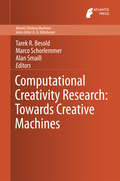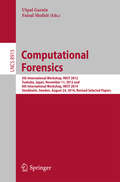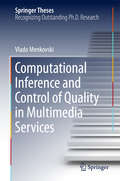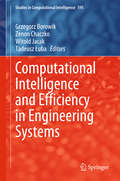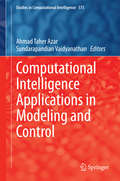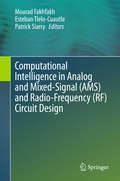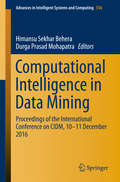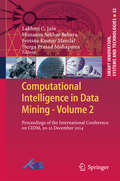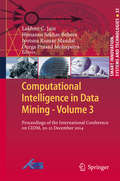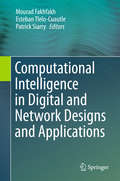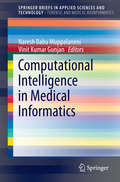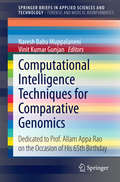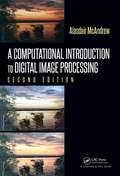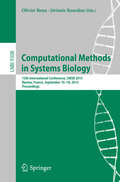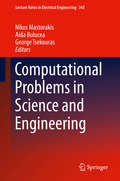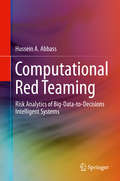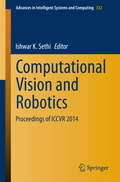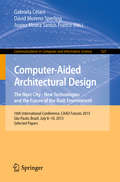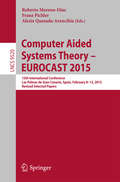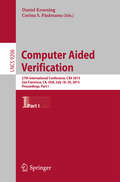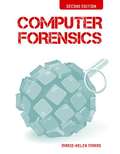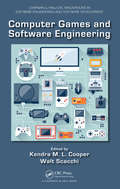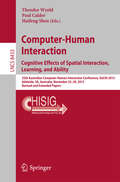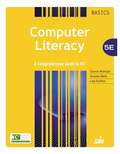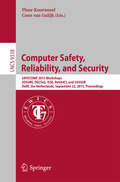- Table View
- List View
Computational Creativity Research: Towards Creative Machines (Atlantis Thinking Machines #7)
by Tarek R. Besold Marco Schorlemmer Alan SmaillComputational Creativity, Concept Invention, and General Intelligence in their own right all are flourishing research disciplines producing surprising and captivating results that continuously influence and change our view on where the limits of intelligent machines lie, each day pushing the boundaries a bit further. By 2014, all three fields also have left their marks on everyday life - machine-composed music has been performed in concert halls, automated theorem provers are accepted tools in enterprises' R&D departments, and cognitive architectures are being integrated in pilot assistance systems for next generation airplanes. Still, although the corresponding aims and goals are clearly similar (as are the common methods and approaches), the developments in each of these areas have happened mostly individually within the respective community and without closer relationships to the goings-on in the other two disciplines. In order to overcome this gap and to provide a common platform for interaction and exchange between the different directions, the International Workshops on "Computational Creativity, Concept Invention, and General Intelligence" (C3GI) have been started. At ECAI-2012 and IJCAI-2013, the first and second edition of C3GI each gathered researchers from all three fields, presenting recent developments and results from their research and in dialogue and joint debates bridging the disciplinary boundaries. The chapters contained in this book are based on expanded versions of accepted contributions to the workshops and additional selected contributions by renowned researchers in the relevant fields. Individually, they give an account of the state-of-the-art in their respective area, discussing both, theoretical approaches as well as implemented systems. When taken together and looked at from an integrative perspective, the book in its totality offers a starting point for a (re)integration of Computational Creativity, Concept Invention, and General Intelligence, making visible common lines of work and theoretical underpinnings, and pointing at chances and opportunities arising from the interplay of the three fields.
Computational Forensics: 5th International Workshop, IWCF 2012, Tsukuba, Japan, November 11, 2012 and 6th International Workshop, IWCF 2014, Stockholm, Sweden, August 24, 2014, Revised Selected Papers (Lecture Notes in Computer Science #8915)
by Utpal Garain Faisal ShafaitThis book constitutes the refereed post-conference proceedings of the 5th and 6th International Workshops on Computational Forensics, IWCF 2012 and IWCF 2014, held in Tsukuba, Japan, in November 2010 and August 2014. The 16 revised full papers and 1 short paper were carefully selected from 34 submissions during a thorough review process. The papers are divided into three broad areas namely biometrics; document image inspection; and applications.
Computational Inference and Control of Quality in Multimedia Services (Springer Theses)
by Vlado MenkovskiThis thesis focuses on the problem of optimizing the quality of network multimedia services. This problem spans multiple domains, from subjective perception of multimedia quality to computer networks management. The work done in this thesis approaches the problem at different levels, developing methods for modeling the subjective perception of quality based on objectively measurable parameters of the multimedia coding process as well as the transport over computer networks. The modeling of subjective perception is motivated by work done in psychophysics, while using Machine Learning techniques to map network conditions to the human perception of video services. Furthermore, the work develops models for efficient control of multimedia systems operating in dynamic networked environments with the goal of delivering optimized Quality of Experience. Overall this thesis delivers a set of methods for monitoring and optimizing the quality of multimedia services that adapt to the dynamic environment of computer networks in which they operate.
Computational Intelligence and Efficiency in Engineering Systems (Studies in Computational Intelligence #595)
by Grzegorz Borowik Zenon Chaczko Witold Jacak Tadeusz ŁubaThis carefully edited and reviewed volume addresses the increasingly popular demand for seeking more clarity in the data that we are immersed in. It offers excellent examples of the intelligent ubiquitous computation, as well as recent advances in systems engineering and informatics. The content represents state-of-the-art foundations for researchers in the domain of modern computation, computer science, system engineering and networking, with many examples that are set in industrial application context. The book includes the carefully selected best contributions to APCASE 2014, the 2nd Asia-Pacific Conference on Computer Aided System Engineering, held February 10-12, 2014 in South Kuta, Bali, Indonesia. The book consists of four main parts that cover data-oriented engineering science research in a wide range of applications: computational models and knowledge discovery; communications networks and cloud computing; computer-based systems; and data-oriented and software-intensive systems.
Computational Intelligence Applications in Modeling and Control (Studies in Computational Intelligence #575)
by Ahmad Taher Azar Sundarapandian VaidyanathanThe development of computational intelligence (CI) systems was inspired by observable and imitable aspects of intelligent activity of human being and nature. The essence of the systems based on computational intelligence is to process and interpret data of various nature so that that CI is strictly connected with the increase of available data as well as capabilities of their processing, mutually supportive factors. Developed theories of computational intelligence were quickly applied in many fields of engineering, data analysis, forecasting, biomedicine and others. They are used in images and sounds processing and identifying, signals processing, multidimensional data visualization, steering of objects, analysis of lexicographic data, requesting systems in banking, diagnostic systems, expert systems and many other practical implementations. This book consists of 16 contributed chapters by subject experts who are specialized in the various topics addressed in this book. The special chapters have been brought out in the broad areas of Control Systems, Power Electronics, Computer Science, Information Technology, modeling and engineering applications. Special importance was given to chapters offering practical solutions and novel methods for the recent research problems in the main areas of this book, viz. Control Systems, Modeling, Computer Science, IT and engineering applications. This book will serve as a reference book for graduate students and researchers with a basic knowledge of control theory, computer science and soft-computing techniques. The resulting design procedures are emphasized using Matlab/Simulink software.
Computational Intelligence in Analog and Mixed-Signal (AMS) and Radio-Frequency (RF) Circuit Design
by Esteban Tlelo-Cuautle Patrick Siarry Mourad FakhfakhThis book explains the application of recent advances in computational intelligence - algorithms, design methodologies, and synthesis techniques - to the design of integrated circuits and systems. It highlights new biasing and sizing approaches and optimization techniques and their application to the design of high-performance digital, VLSI, radio-frequency, and mixed-signal circuits and systems. This first of two related volumes addresses the design of analog and mixed-signal (AMS) and radio-frequency (RF) circuits, with 17 chapters grouped into parts on analog and mixed-signal applications, and radio-frequency design. It will be of interest to practitioners and researchers in computer science and electronics engineering engaged with the design of electronic circuits.
Computational Intelligence in Data Mining: Proceedings of the International Conference on CIDM, 10-11 December 2016 (Advances in Intelligent Systems and Computing #556)
by Himansu Sekhar Behera Durga Prasad MohapatraThe contributed volume aims to explicate and address the difficulties and challenges that of seamless integration of the two core disciplines of computer science, i. e. , computational intelligence and data mining. Data Mining aims at the automatic discovery of underlying non-trivial knowledge from datasets by applying intelligent analysis techniques. The interest in this research area has experienced a considerable growth in the last years due to two key factors: (a) knowledge hidden in organizations' databases can be exploited to improve strategic and managerial decision-making; (b) the large volume of data managed by organizations makes it impossible to carry out a manual analysis. The book addresses different methods and techniques of integration for enhancing the overall goal of data mining. The book helps to disseminate the knowledge about some innovative, active research directions in the field of data mining, machine and computational intelligence, along with some current issues and applications of related topics.
Computational Intelligence in Data Mining - Volume 1: Proceedings of the International Conference on CIDM, 20-21 December 2014 (Smart Innovation, Systems and Technologies #32)
by Lakhmi C. Jain Himansu Sekhar Behera Durga Prasad Mohapatra Jyotsna Kumar MandalThe contributed volume aims to explicate and address the difficulties and challenges for the seamless integration of two core disciplines of computer science, i. e. , computational intelligence and data mining. Data Mining aims at the automatic discovery of underlying non-trivial knowledge from datasets by applying intelligent analysis techniques. The interest in this research area has experienced a considerable growth in the last years due to two key factors: (a) knowledge hidden in organizations' databases can be exploited to improve strategic and managerial decision-making; (b) the large volume of data managed by organizations makes it impossible to carry out a manual analysis. The book addresses different methods and techniques of integration for enhancing the overall goal of data mining. The book helps to disseminate the knowledge about some innovative, active research directions in the field of data mining, machine and computational intelligence, along with some current issues and applications of related topics.
Computational Intelligence in Data Mining - Volume 3: Proceedings of the International Conference on CIDM, 20-21 December 2014 (Smart Innovation, Systems and Technologies #33)
by Lakhmi C. Jain Himansu Sekhar Behera Durga Prasad Mohapatra Jyotsna Kumar MandalThe contributed volume aims to explicate and address the difficulties and challenges for the seamless integration of two core disciplines of computer science, i. e. , computational intelligence and data mining. Data Mining aims at the automatic discovery of underlying non-trivial knowledge from datasets by applying intelligent analysis techniques. The interest in this research area has experienced a considerable growth in the last years due to two key factors: (a) knowledge hidden in organizations' databases can be exploited to improve strategic and managerial decision-making; (b) the large volume of data managed by organizations makes it impossible to carry out a manual analysis. The book addresses different methods and techniques of integration for enhancing the overall goal of data mining. The book helps to disseminate the knowledge about some innovative, active research directions in the field of data mining, machine and computational intelligence, along with some current issues and applications of related topics.
Computational Intelligence in Digital and Network Designs and Applications
by Esteban Tlelo-Cuautle Patrick Siarry Mourad FakhfakhThis book explains the application of recent advances in computational intelligence - algorithms, design methodologies, and synthesis techniques - to the design of integrated circuits and systems. It highlights new biasing and sizing approaches and optimization techniques and their application to the design of high-performance digital, VLSI, radio-frequency, and mixed-signal circuits and systems. This second of two related volumes addresses digital and network designs and applications, with 12 chapters grouped into parts on digital circuit design, network optimization, and applications. It will be of interest to practitioners and researchers in computer science and electronics engineering engaged with the design of electronic circuits.
Computational Intelligence in Medical Informatics (SpringerBriefs in Applied Sciences and Technology)
by Vinit Kumar Gunjan Naresh Babu MuppalaneniThis Brief highlights Informatics and related techniques to Computer Science Professionals, Engineers, Medical Doctors, Bioinformatics researchers and other interdisciplinary researchers. Chapters include the Bioinformatics of Diabetes and several computational algorithms and statistical analysis approach to effectively study the disorders and possible causes along with medical applications.
Computational Intelligence Techniques for Comparative Genomics: Dedicated to Prof. Allam Appa Rao on the Occasion of His 65th Birthday (SpringerBriefs in Applied Sciences and Technology)
by Vinit Kumar Gunjan Naresh Babu MuppalaneniThis Brief highlights Informatics and related techniques to Computer Science Professionals, Engineers, Medical Doctors, Bioinformatics researchers and other interdisciplinary researchers. Chapters include the Bioinformatics of Diabetes and several computational algorithms and statistical analysis approach to effectively study the disorders and possible causes along with medical applications.
A Computational Introduction To Digital Image Processing, Second Edition
by Alasdair McandrewHighly Regarded, Accessible Approach to Image Processing Using Open-Source and Commercial Software A Computational Introduction to Digital Image Processing, Second Editionexplores the nature and use of digital images and shows how they can be obtained, stored, and displayed. Taking a strictly elementary perspective, the book only covers topics that involve simple mathematics yet offer a very broad and deep introduction to the discipline. New to the Second Edition This second edition provides users with three different computing options. Along with MATLAB®, this edition now includes GNU Octave and Python. Users can choose the best software to fit their needs or migrate from one system to another. Programs are written as modular as possible, allowing for greater flexibility, code reuse, and conciseness. This edition also contains new images, redrawn diagrams, and new discussions of edge-preserving blurring filters, ISODATA thresholding, Radon transform, corner detection, retinex algorithm, LZW compression, and other topics. Principles, Practices, and Programming Based on the author's successful image processing courses, this bestseller is suitable for classroom use or self-study. In a straightforward way, the text illustrates how to implement imaging techniques in MATLAB, GNU Octave, and Python. It includes numerous examples and exercises to give students hands-on practice with the material.
Computational Methods in Systems Biology: 13th International Conference, CMSB 2015, Nantes, France, September 16-18, 2015, Proceedings (Lecture Notes in Computer Science #9308)
by Olivier Roux Jérémie BourdonThis book constitutes the refereed proceedings of the 13th International Conference on Computational Methods in Systems Biology, CMSB 2015, held in Nantes, France, in September 2015. The 20 full papers and 2 short papers presented were carefully reviewed and selected from 43 full and 4 short paper submissions. The papers cover a wide range of topics in the analysis of biological systems, networks and data such as model checking, stochastic analysis, hybrid systems, circadian clock, time series data, logic programming, and constraints solving ranging from intercellular to multiscale.
Computational Problems in Science and Engineering (Lecture Notes in Electrical Engineering #343)
by Nikos Mastorakis Aida Bulucea George TsekourasThis book provides readers with modern computational techniques for solving variety of problems from electrical, mechanical, civil and chemical engineering. Mathematical methods are presented in a unified manner, so they can be applied consistently to problems in applied electromagnetics, strength of materials, fluid mechanics, heat and mass transfer, environmental engineering, biomedical engineering, signal processing, automatic control and more.
Computational Red Teaming: Risk Analytics of Big-Data-to-Decisions Intelligent Systems
by Hussein A. AbbassWritten to bridge the information needs of management and computational scientists, this book presents the first comprehensive treatment of Computational Red Teaming (CRT). The author describes an analytics environment that blends human reasoning and computational modeling to design risk-aware and evidence-based smart decision making systems. He presents the Shadow CRT Machine, which shadows the operations of an actual system to think with decision makers, challenge threats, and design remedies. This is the first book to generalize red teaming (RT) outside the military and security domains and it offers coverage of RT principles, practical and ethical guidelines. The author utilizes Gilbert's principles for introducing a science. Simplicity: where the book follows a special style to make it accessible to a wide range of readers. Coherence: where only necessary elements from experimentation, optimization, simulation, data mining, big data, cognitive information processing, and system thinking are blended together systematically to present CRT as the science of Risk Analytics and Challenge Analytics. Utility: where the author draws on a wide range of examples, ranging from job interviews to Cyber operations, before presenting three case studies from air traffic control technologies, human behavior, and complex socio-technical systems involving real-time mining and integration of human brain data in the decision making environment.
Computational Vision and Robotics: Proceedings of ICCVR 2014 (Advances in Intelligent Systems and Computing #332)
by Ishwar K. SethiComputer Vision and Robotic is one of the most challenging areas of 21st century. Its application ranges from Agriculture to Medicine, Household applications to Humanoid, Deep-sea-application to Space application, and Industry applications to Man-less-plant. Today's technologies demand to produce intelligent machine, which are enabling applications in various domains and services. Robotics is one such area which encompasses number of technology in it and its application is widespread. Computational vision or Machine vision is one of the most challenging tools for the robot to make it intelligent. This volume covers chapters from various areas of Computational Vision such as Image and Video Coding and Analysis, Image Watermarking, Noise Reduction and Cancellation, Block Matching and Motion Estimation, Tracking of Deformable Object using Steerable Pyramid Wavelet Transformation, Medical Image Fusion, CT and MRI Image Fusion based on Stationary Wavelet Transform. The book also covers articles from applications of soft computing techniques such as Target Searching and Tracking using Particle Swarm Optimization, PSO-based Functional Artificial Neural Network, etc. The book also covers article from the areas of Robotics such as Solar Power Robot Vehicle, Multi Robot Area Exploration, Intelligent Driving System based on Video Sequencing, Emotion Recognition using MLP Network, Identifying the Unstructured Environment.
Computer-Aided Architectural Design Futures. The Next City - New Technologies and the Future of the Built Environment: 16th International Conference, CAAD Futures 2015, São Paulo, Brazil, July 8-10, 2015. Selected Papers (Communications in Computer and Information Science #527)
by Gabriela Celani David Moreno Sperling Juarez Moara Santos FrancoThis book constitutes the refereed proceedings of the 16th International Conference on Computer-Aided Architectural Design Futures, CAAD Futures 2015, held in São Paulo, Brazil, in July 2015. The 33 revised full papers presented were carefully reviewed and selected from 200 submissions. The papers are organized in topical sections on modeling, analyzing and simulating the city; sustainability and performance of the built space; automated and parametric design; building information modelling (BIM); fabrication and materiality; shape studies.
Computer Aided Systems Theory - EUROCAST 2015: 15th International Conference, Las Palmas de Gran Canaria, Spain, February 8-13, 2015, Revised Selected Papers (Lecture Notes in Computer Science #9520)
by Roberto Moreno-Díaz Franz Pichler Alexis Quesada-ArencibiaThis volume constitutes the papers presented at the 15thInternational Conference on Computer Aided Systems Theory, EUROCAST 2015, heldin February 2015 in Las Palmas de Gran Canaria, Spain. The total of 107 papers presented were carefully reviewedand selected for inclusion in the book. The contributions are organized intopical sections on Systems Theory and Applications; Modelling BiologicalSystems; Intelligent Information Processing; Theory and Applications ofMetaheuristic Algorithms; Computer Methods, Virtual Reality and ImageProcessing for Clinical and Academic Medicine; Signals and Systems inElectronics; Model-Based System Design, Verification, and Simulation; DigitalSignal Processing Methods and Applications; Modelling and Control of Robots;Mobile Platforms, Autonomous and Computing Traffic Systems; Cloud and OtherComputing Systems; and Marine Sensors and Manipulators.
Computer Aided Verification: 27th International Conference, CAV 2015, San Francisco, CA, USA, July 18-24, 2015, Proceedings, Part I (Lecture Notes in Computer Science #9206)
by Daniel Kroening Corina S. PăsăreanuThe two-volume set LNCS 9206 and LNCS 9207 constitutes the refereed proceedings of the 27th International Conference on Computer Aided Verification, CAV 2015, held in San Francisco, CA, USA, in July 2015. The total of 58 full and 11 short papers presented in the proceedings was carefully reviewed and selected from 252 submissions. The papers were organized in topical sections named: model checking and refinements; quantitative reasoning; software analysis; lightning talks; interpolation, IC3/PDR, and Invariants; SMT techniques and applications; HW verification; synthesis; termination; and concurrency.
Computer Forensics: Cybercriminals, Laws, and Evidence
by Marie-Helen MarasAn Updated Edition of the Definitive Computer Forensics Text. Updated to include the most current events and information on cyberterrorism, the second edition of Computer Forensics: Cybercriminals, Laws, and Evidence continues to balance technicality and legal analysis as it enters into the world of cybercrime by exploring what it is, how it is investigated, and the regulatory laws around the collection and use of electronic evidence. Students are introduced to the technology involved in computer forensic investigations and the technical and legal difficulties involved in searching, extracting, maintaining, and storing electronic evidence, while simultaneously looking at the legal implications of such investigations and the rules of legal procedure relevant to electronic evidence. Significant and current computer forensic developments are examined, as well as the implications for a variety of fields including computer science, security, criminology, law, public policy, and administration.
Computer Games and Software Engineering (Chapman & Hall/CRC Innovations in Software Engineering and Software Development Series)
by Kendra M. L. Cooper Walt ScacchiComputer games represent a significant software application domain for innovative research in software engineering techniques and technologies. Game developers, whether focusing on entertainment-market opportunities or game-based applications in non-entertainment domains, thus share a common interest with software engineers and developers on how to
Computer-Human Interaction. Cognitive Effects of Spatial Interaction, Learning, and Ability: 25th Australian Computer-Human Interaction Conference, OzCHI 2013, Adelaide, SA, Australia, November 25-29, 2013. Revised and Extended Papers (Lecture Notes in Computer Science #8433)
by Theodor Wyeld Paul Calder Haifeng ShenThis book constitutes the thoroughly refereed post-conference proceedings of the 25th Australian Conference on Computer-Human Interaction, OzCHI 2013, held in Adelaide, SA, Australia, in November 2013. The 11 revised extended papers were carefully reviewed and selected from 192 submissions and cover topics on multi-dimensional interaction; video gaming; spatial learning; and physical spatial interaction.
Computer Literacy Basics: A Comprehensive Guide to IC³
by Connie Morrison Dolores Wells Lisa RuffoloBring your computer literacy course back to the BASICS. COMPUTER LITERACY BASICS: A COMPREHENSIVE GUIDE TO IC3 provides an introduction to computer concepts and skills, which maps to the newest Computing Core Certification (IC3) standards. Designed with new learners in mind, this text covers Computing Fundamentals, Key Applications, and Living Online - everything students need to pass the IC3 exam, and finish the course as confident computer users.
Computer Safety, Reliability, and Security: SAFECOMP 2015 Workshops, ASSURE, DECSoS. ISSE, ReSA4CI, and SASSUR, Delft, The Netherlands, September 22, 2015, Proceedings (Lecture Notes in Computer Science #9338)
by Floor Koornneef Coen Van GulijkThis book constitutes the refereed proceedings of the 34th International Conference on Computer Safety, Reliability, and Security, SAFECOMP 2015, held in Delft, The Netherlands, in September 2014. The 32 revised full papers presented together with 3 invited talks were carefully reviewed and selected from 104 submissions. The papers are organized in topical sections on flight systems, automotive embedded systems, automotive software, error detection, medical safety cases, medical systems, architecture and testing, safety cases, security attacks, cyber security and integration, and programming and compiling.
